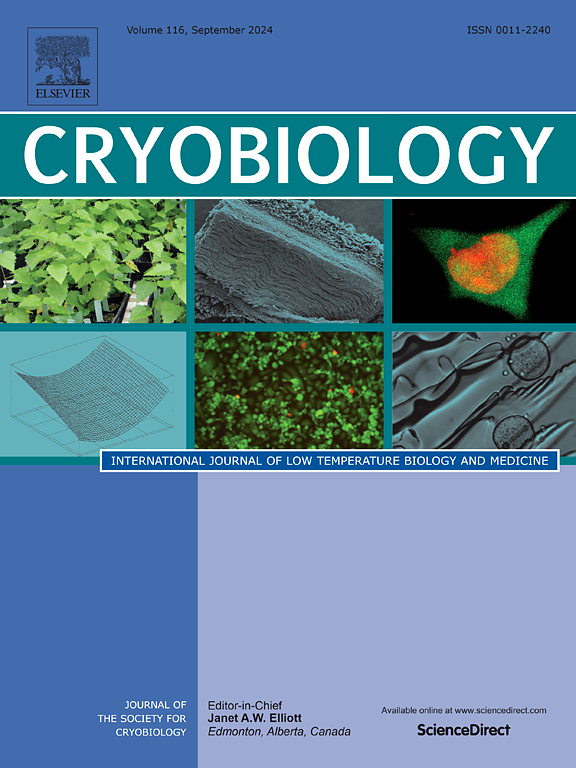Reducing dimethyl sulfoxide content in Jurkat cell formulations suitable for cryopreservation
IF 2.1
3区 生物学
Q2 BIOLOGY
引用次数: 0
Abstract
Cell-based medicinal products (CBMPs) are usually cryopreserved in formulations containing up to 10 % dimethyl sulfoxide (Me2SO) at temperatures below −145 °C. Although Me2SO effectively protects cells during the freezing process, it can be damaging to cells at ambient temperatures and lead to side effects in patients. The aim of this study was to reduce the amount of Me2SO in cryopreservation formulations for an immortalized T cell line (Jurkat cells). A design of experiment (DoE) approach was applied for formulation development using seven different excipients, i.e., Me2SO, trehalose, sorbitol, proline, ectoine, poloxamer 188 (P188) and poly vinyl pyrrolidone 40 (PVP). A DoE model was generated to predict optimal formulations resulting in a high post-thaw viability and a high glass transition temperature of the formulation to allow for frozen storage without the use of liquid nitrogen. Subsequently a stability study was performed with promising lead candidates over three months at storage temperatures of −145 °C, −80 °C, −40 °C. Three benchmark solutions were used, i.e., Cryostor CS10, CryoSOfree as well as 10 % Me2SO in Roswell Park Memorial Institute Medium (RPMI). The excipient affecting the post-thaw viability of Jurkat cells the most was, as expected, Me2SO, which led to increased viabilities at higher concentrations. Most formulations resulted in similar viabilities for cells stored at −145 °C and −80 °C, whereas samples stored at −40 °C did not survive. In general, benchmark formulations resulted in slightly higher viabilities than the tested formulations. Furthermore, cell samples stored at −80 °C were recultivated in cell culture and the viability was assessed after 24h. The cell viability after 24h was much lower compared to the cells analyzed directly post-thaw, indicating that freeze-thaw damages continue to unfold after thawing. In summary, several promising excipients and combinations thereof, e.g., trehalose and PVP, were identified for the cryopreservation of Jurkat cells with reduced concentrations of Me2SO or Me2SO-free cryopreservation. Additionally, storage at −80 °C is possible for the developed formulations.
降低适用于低温保存的Jurkat细胞制剂中二甲亚砜的含量
细胞基药物(CBMPs)通常在低于- 145°C的温度下冷冻保存在含有高达10%的二甲亚砜(Me2SO)的配方中。虽然Me2SO在冷冻过程中可以有效地保护细胞,但它在环境温度下会对细胞造成损害,并对患者产生副作用。本研究的目的是减少永生化T细胞系(Jurkat细胞)冷冻保存制剂中Me2SO的含量。采用实验设计(DoE)方法,采用Me2SO、海藻糖、山梨糖醇、脯氨酸、异构体碱、波洛沙姆188 (P188)和聚乙烯吡咯烷酮40 (PVP) 7种辅料进行配方开发。建立了DoE模型来预测最佳配方,从而使配方具有高解冻后活力和高玻璃化转变温度,从而允许在不使用液氮的情况下进行冷冻储存。随后,在- 145°C, - 80°C, - 40°C的储存温度下,对有希望的候选铅进行了为期三个月的稳定性研究。使用三种基准溶液,即Cryostor CS10, CryoSOfree和10% Me2SO在Roswell Park Memorial Institute Medium (RPMI)中。正如预期的那样,对Jurkat细胞解冻后存活率影响最大的辅料是Me2SO,高浓度的Me2SO会增加Jurkat细胞的存活率。大多数配方在- 145°C和- 80°C保存的细胞中产生相似的存活率,而在- 40°C保存的样品则无法存活。一般来说,基准配方比测试配方的可行性略高。在- 80°C保存的细胞样品重新培养,24h后评估细胞活力。与解冻后直接分析的细胞相比,24h后的细胞活力明显降低,表明冻融损伤在解冻后继续显现。综上所述,几种有前景的赋形剂及其组合,如海藻糖和PVP,被确定用于降低Me2SO浓度或不含Me2SO的Jurkat细胞低温保存。此外,开发的配方可以在- 80°C下存储。
本文章由计算机程序翻译,如有差异,请以英文原文为准。
求助全文
约1分钟内获得全文
求助全文
来源期刊

Cryobiology
生物-生理学
CiteScore
5.40
自引率
7.40%
发文量
71
审稿时长
56 days
期刊介绍:
Cryobiology: International Journal of Low Temperature Biology and Medicine publishes research articles on all aspects of low temperature biology and medicine.
Research Areas include:
• Cryoprotective additives and their pharmacological actions
• Cryosurgery
• Freeze-drying
• Freezing
• Frost hardiness in plants
• Hibernation
• Hypothermia
• Medical applications of reduced temperature
• Perfusion of organs
• All pertinent methodologies
Cryobiology is the official journal of the Society for Cryobiology.
 求助内容:
求助内容: 应助结果提醒方式:
应助结果提醒方式:


